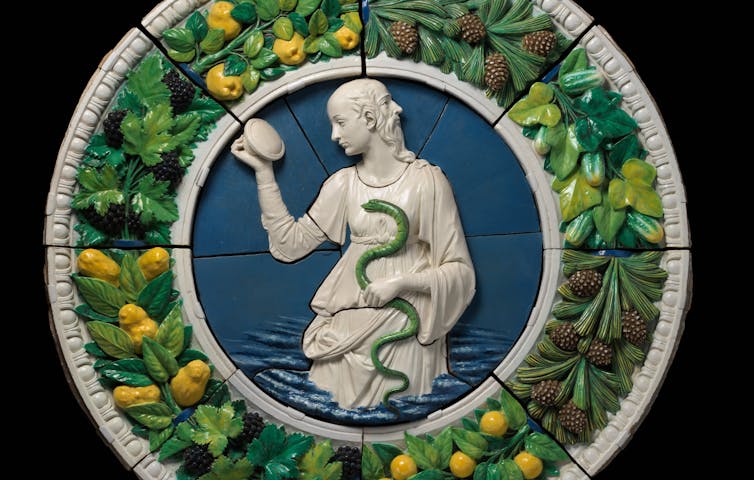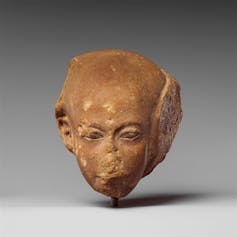At least 40% of women experience hair loss or alopecia over their lifetimes. This could be alopecia areata (patchy hair loss), traction alopecia (strained hair loss) or another form. The different ways that women’s hair loss has been depicted across art history demonstrates the many different ways it has been interpreted over the years.
In 16th and 17th century Britain, for example, women’s alopecia was sometimes interpreted as retribution for sins, including adultery.
Some historical art, however, depicts a more neutral, or even positive, attitude towards women’s alopecia. In religious or mythical art, it was sometimes idealised as divine.
National Gallery of Art/Musée Fesch
Madonna and Child, painted in the 15th century by Italian Rennaisance artist Carlo Crivelli, shows Jesus and Mary embracing in a gold, stylised setting. The pair sit behind a religious altar surrounded by ripe fruit and adorned with halos. Madonna has a high forehead and her blonde hair recedes, particularly on her right temple.
This association between alopecia and divinity is echoed in a work by another Renaissance Italian artist, Cosmè Tura. His Madonna and Mary Magdalene (circa 1490) depicts both mother and child with prominent foreheads.

Met Museum
A glazed terracotta piece created by the Italian sculptor Andrea della Robbia in 1475 features Prudence, a human embodiment of Christian morality, as a balding two-headed person.
Baldness in women has been connected to the divine for various reasons. It took the emphasis off of personal appearance in favour of deeper, more spiritual, priorities. But intentional hair removal played a role too. For some religious people, such as Buddhist nuns and Haredi Jewish wives, a bald head is thought to be purer and shaving can represent a regular, sacrificial ritual.
Ancient depictions

Met Museum
Artwork on the walls of the tomb of the ancient Egyptian pharaoh, Akhenaten who ruled from 1351 to 1334BC, depicts two of his daughters, naked, with bald heads. Head shaving as well as natural baldness was common among the ancient Egyptians, including women.

Met Museum
In fact, ancient Egyptians had distinct terms for female and male alopecia. This attests to just how common baldness, head shaving and wig wearing were for both sexes in ancient Egypt.
And it isn’t just Egypt. Partial and full head shaving has historically been common among women across sub-Saharan Africa. As one traveller observed among the inhabitants of the 18th century Kingdom of Issini (modern-day Ghana): “Some only shave one half of the head … Others leave broad patches here and there unshaved.”
Medieval and Renaissance alopecia
The 15th century painting, Portrait Of A Woman With A Man At A Casement, by the Italian artist, Fra Filippo Lippi, features an aristocratic profile of a woman facing a man. She has a prominent forehead and high hairline.

Met Museum
The appearance of recessed frontal hairlines in Medieval and Renaissance Europe may have been fashionable and even considered a sign of intelligence, encouraging customs of forehead shaving and eyebrow plucking.
The 16th century queen of England, Elizabeth I, was often painted in this way. One undated oil portrait of the British monarch depicts her in bejewelled robes, with a pearl emblazoned veil and a prominent forehead.
The removal of female bodily hair at this time, including on the forehead, wasn’t just a matter of fashion. It also arguably arose due to patriarchal ideas that women’s body hair was dirty and even dangerous to men.
Modern alopecia
Adverts and research today tend to discuss hair loss exclusively through medical terms, as a kind of detrimental disease. A recent BBC article refers to people with alopecia areata as “patients” and their experience of it as “profoundly challenging”. This certainly reflects some experiences, but not those who interpret their hair loss more neutrally, or even with pride.
Pharmaceutical and cosmetic products are promoted as “necessary” treatments. A newly licensed drug, litfulo or ritlecitinib, has been hailed this week as the “first treatment” and “medicine” for alopecia. But as many forms of alopecia are not delimiting and as the “treatments” on offer have limited efficacy and potential safety issues, this should not be the default response. For example, the European Medicine Agency notes that ritlecitinib results in 80% hair regrowth but only for 36% of people taking it. About 10% are at risk of diarrhoea, acne and throat infections.
Another study noted that similar alopecia drugs, that operate through immunosuppression, only seem to work if they are taken continuously, yet their long-term safety has not been established.
Depictions of alopecia throughout art history are a reminder of the many complicated ways women’s hair loss has been viewed. Sometimes weaponised as a way to shame women, sometimes venerated as a sign of the divine, the truth is that hair loss really indicates nothing about a woman’s worth, morality or status.
But historical depictions of women’s alopecia and baldness provide hope. They show that alopecia has been conceptualised differently at different times. This means the current framing of alopecia as an inevitably disadvantaging disease in need of certain “treatments” might be biased too. They suggest if our societal interpretation of alopecia improves (as something that shouldn’t be stigmatised), then so too may the individual experience (as something that shouldn’t be dreaded).

Looking for something good? Cut through the noise with a carefully curated selection of the latest releases, live events and exhibitions, straight to your inbox every fortnight, on Fridays. Sign up here.








